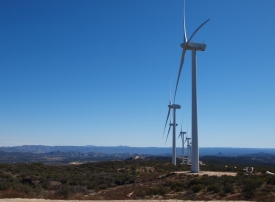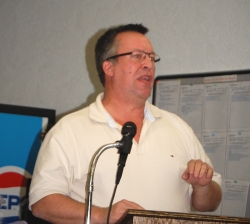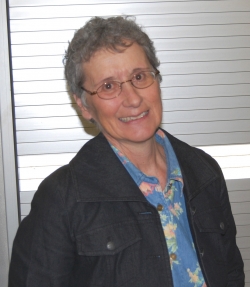Appraiser says average loss in home values is 25 percent
 By Billie Jo Jannen
By Billie Jo Jannen
For East County Magazine
January 28, 2011 (San Diego’s East County) --East County residents who oppose a growing collection of industrial wind turbines proposed near rural residences have discovered that they have much in common with wind farm neighbors in the United Kingdom, Australia, Germany, Japan, Canada and other parts of the United States. Residents who have lived near windmills for years are now publicizing impacts to health and property values.
In fact, a standing-room-only crowd got an earful on those impacts last Wednesday, when experts from Illinois and Canada discussed them at the Boulevard Fire Station.
Experts speak on impacts to health, property values
Speakers included appraisal consultant Mike McCann, of Chicago, Ill., Carmen Krogh, of Ontario, Canada, Bill Powers, of Powers Engineering in San Diego, Dave Elliott, of Boulevard, and Donna Tisdale, also of Boulevard.
 McCann stated in no uncertain terms that property value losses of about 25 percent are becoming the norm within two miles of a wind farm. Krogh shared a litany of health ills related to the strobe light affect of the turbines and both audible and inaudible sound.
McCann stated in no uncertain terms that property value losses of about 25 percent are becoming the norm within two miles of a wind farm. Krogh shared a litany of health ills related to the strobe light affect of the turbines and both audible and inaudible sound.
Reported health effects include sleep deprivation, headaches, heart palpitations, vertigo, tinnitus, gastrointestinal problems, anxiety and cognitive impairment, Krogh said. Matching results are reported in every country that has erected large numbers of industrial turbines, she added.
Krogh, a retired pharmacist who networks with health professionals worldwide to track and document wind turbine health affects, said the impacts of both audible and inaudible sound cannot be mitigated: “The only mitigation is to remove the people from the environment they are in,” she said.
McCann - whose resume includes real estate zoning evaluations, property value impact studies, analysis of wind turbine generating facilities and evaluation of eminent domain real estate acquisitions - advised residents bluntly that no permits should be issued on any wind generation project without a property value guarantee for homeowners in the turbine area of influence.
The impact zone of a wind farm is two to five miles, he said. In addition to 20 to 40 percent value loss of homes in that area, residents have increased costs of health care, costs to try to retrofit homes to block noise or the strobe light affect of the turbine shadows, and the complete losses of people who are forced to walk away from their homes.
Scale of local proposed projects
In the Boulevard planning area, 392 turbines are wending their way through the permitting process, according to Tisdale. Hundreds more are planned in Ocotillo and Jacume, Mexico, immediately south of Jacumba, she added. The current San Diego County wind ordinance makes no provision for property value guarantees, nor are health impacts currently tracked or considered in the permitting process.
The additional windmills include a project of the Campo Band of Mission Indians, which is partnering with Invenergy and San Diego Gas & Electric (SDG&E) to add another round of turbines to its existing wind farm. The proposed project, which is not under county permitting authority, is projected to produce as much as 160 megawatts of energy.
Wind powers economic opportunity for tribe
In a statement supporting the construction of a large power substation in Jacumba, the tribe’s chairwoman, Monique LaChappa, wrote, “We’re excited about the possibility of developing another wind farm on our reservation. In order to move forward with development, we need adequate transmission to bring this project -- and other renewable energy projects -- online. We support SDG&E’s efforts to construct its proposed ECO Substation project.”
La Chappa added that Native Americans consider themselves to be caretakers of the earth, with a responsibility to help protect the environment and our sacred resources. “Our tribe’s renewable energy investments fit with these traditional values,” she added.
Asked if the Chairwoman was familiar with the alleged health issues and property value concerns, a spokesperson for LaChappa pledged to ask for a response but could not obtain comment in time for press deadline on this article.
Residents voice concerns
Several meeting attendees, one who lives as far as two miles from the existing wind farm on Campo Reservation, commented that they can hear the turbines clearly, even inside their homes. McCann said that wind turbine noise can travel up to nine miles in mountain terrain.
“I’m calling for a moratorium pending studies of health impacts,” said Tisdale, who recently attended an international symposium of doctors, researchers and other health professionals who have documented wind turbine health effects worldwide.
Effects on children cited
Both McCann and Krogh said that a number of turbine neighbors had walked away from their homes, because they could not live with the impacts and no one would buy their homes. Others must find someplace away from the turbines to sleep and many have had to send their children to live with relatives to clear up various illnesses.
Adequate research on the long-term affects of turbine noise on growing children has not been done, Krogh said. However, according to Arline Bronzaft, B.A., M.A., Ph.D., who spoke at the Oct. 30 International Symposium on Adverse Health Effects from Wind Turbines, her research has demonstrated that intrusive noises, such as passing traffic or overhead aircraft, adversely affect children’s cardiovascular systems, memory, language development and ability to learn.
The title of Bronzaft’s presentation was “Children: The Canaries in the Coal Mine.”
Asked what local clinics might do to mitigate health problems that could develop from proposed area wind farms, Krogh said there literally are none, though local health professionals can help by gathering information: “A clinic can assist by documenting impacts to its patients.”
Global issues
 Krogh brought filmed interviews with wind turbine neighbors from Norway, Canada and Japan. The sound levels from their homes, in some cases, drowned out their voices and the nature of the sound was so distressing that audience members asked that it be turned down.
Krogh brought filmed interviews with wind turbine neighbors from Norway, Canada and Japan. The sound levels from their homes, in some cases, drowned out their voices and the nature of the sound was so distressing that audience members asked that it be turned down.
Krogh is a member of Society for Wind Vigilance, an international federation of physicians, acousticians and other professionals who seek to quantify heath risks and ensure that permitting authorities and wind turbine operators acknowledge and remedy those risks. So far, she said, there has been great resistance from governments, who seek to provide “green” alternatives and who receive tax money from wind farm profits.
Industrial wind farm operators in the United States and Canada, most of whom receive taxpayer supported benefits and highly favorable permit conditions, resist revelations of adverse effects by requiring property owners from whom they lease lands to sign non-disclosure agreements, McCann said. The few off-site residents that have received buy-out offers from wind companies are required to sign non-disclosure agreements as a condition of the buy-out.
Property values and legal rights weighed
McCann added that property value losses are not offset by local jobs or by lease payments to property owners. The leases are often predicated on the power the turbine produces and few of them actually work at maximum capacity. Hence, “They (landowners) aren’t getting what they were promised,” he said.
“Always have a lawyer look at the lease document before you sign it,” he advised. Among the small print items to be aware of is what is going to happen to the turbine when it is taken out of service. The I-10 in Nevada is littered with carcasses of turbines that are no longer useful, but they have never been removed, he said.
Large companies further “defuse their liability” by creating smaller limited liability companies to actually own and operate the wind farms, McCann said.
The mass erection of wind turbines near people’s homes is a form of taking from the property owner and giving to the wind developers, he added. “It’s not okay to rob from Peter to pay Paul.”
Property value impacts start to show up as soon as the possibility of a project becomes known, according to McCann. The phenomenon even has a name among appraisal professionals: wind farm anticipation stigma.
In a comment paper on the Brucci MET tower on La Posta Road, he asserted that the construction of a meteorological testing tower “serves as constructive notice to existing neighboring property owners and any potential buyers” that wind turbines may come in later - and that is enough to drive homebuyers elsewhere.
According to nolo.com, a law information website, California sellers must disclose any and every natural and manmade hazard that might affect the value of the property. This includes everything from neighborhood nuisances, such as a dog that barks every night, to major hazards like floods, earthquakes, fires, environmental hazards, and other problems. Failure to make the required disclosures not only costs the seller in a lawsuit, but can also carry criminal penalties.
So what is a homeowner to do if his home is untenable and no one else wants it either? “It’s really sad to talk to these people who put their life savings into their homes and then have to walk away from them,” McCann said.
The county’s wind ordinance calls for permitting requirements to state noise limitations at the property line, but makes no provisions for property value protections or mitigation of health impacts, according to Planning Manager Joe Farace of San Diego County Department of Planning and Land Use.
That’s a different realm from what we do,” Farace said. State and federal environmental and planning laws don’t require that these impacts be quantified or mitigated, though the county could, if it wishes, explore going beyond those minimums.
“This is so new,” he said. “We’d have to work with county counsel to see what we could do.”
Farace said there are no plans, currently, to pursue such a discussion.
County health official to review health information on turbines
Dr. Wilma J. Wooten, San Diego County’s public health officer, sat in on a meeting with District 2 Supervisor Dianne Jacob, McCann, Krogh and Tisdale last week. She later told East County Magazine that she plans to continue to gather and review information on the subject.
“We have to be open to learning the unintended consequences of what seems like a good idea,” she said. “I’m looking at the health effects … If any action is taken, it would be by the board of supervisors.”
A local Indian voices concerns
Those unintended consequences may also be hurting local Indians, according to Dave Elliott, who lives on Manzanita Reservation about half a mile from the Campo tribe’s first wind installation. After speaking with Krogh, Elliott told East County Magazine, he put the pieces together on health problems he and some of his neighbors have experienced in recent years – among these a heart attack that he now suspects may be connected to wind turbines, which have been linked to irregular heartbeats.
“I was perfectly healthy before,” he said. “I think the health impacts should be put out to the public more.”
“People don’t hear about this side,” Elliott added. “They just accept what the officials say.”
Elliott is a Kumeyaay cultural monitor who works for a subcontractor tasked with identifying and protecting such cultural assets as Kumeyaay ceremonial grounds and burial sites. Large swathes of Indian history and culture, he says, are being lost in the rush to erect the Sunrise Powerlink and turbines.
“Once it’s destroyed, it’s gone forever,” he said sadly.
Elliott is also of the opinion that Indians are not getting the money they should for allowing green gold projects on their lands. “The Native American people are selling themselves short … and not really realizing all the consequences.”
Manzanita is also talking with wind developers, but Elliott said he is unsure how that will pan out in light of revelations about health problems linked to the turbines.
Supervisor Jacob opposes expansion of wind farm
At least one supervisor, East County’s Dianne Jacob, is definitely not in favor of adding more wind turbines, citing rooftop solar as a superior option:
“If the goal is self-sufficiency, homes and businesses must become their own power plants and avoid being gouged by a company that will stop at nothing, not even human life, to keep the profits rolling in,” Jacob said. “A better approach is to use rooftop solar on existing structures to put power in the hands of the people, not a monopoly utility company.”
Jacob cited the growing body of information on health impacts – as yet unstudied in neighbors of the existing turbines - the cost to ratepayers, intense industrialization pressure on backcountry lands and damage to historic and cultural sites as reasons to put the brakes on wind turbine and transmission projects.
Tisdale said she is asking that the county permitting process make provision for property value guarantees, relocation of impacted residents, evidence-supported setbacks and protections in the noise ordinance to include low frequency and sub-audible effects.
The Boulevard Planning Group will discuss and vote on the request at its Feb. 3 meeting.









Comments
Recently I came across your
Recently I came across your blog and read along. I thought I would leave my first comment. I do not know what to say except that I liked reading. Nice blog.
Home Values are Affected!!
Replying to person who commented about the National Berkely U.S. Department energy funded paper:
Of those homes sited only 125 were within 1 mile of the turbines. And, of that only .8% were within 3000 feet. The author used hedonic statistic rather than Paired sales. The person was also NOT a real estate professional.
a. I don't know whether the authors of that paper accounted for: Homes never sold? Or homes bought out by the wind company.
Lawrence Berkeley Laboratory study proves this untrue
The Lawrence Berkeley Energy Lab studied this precise question. itself.
The researchers analyzed 7,500 single family home sales and made site visits. They broke the homes out by those less than a mile away from a turbine, between one and three miles, between three and five miles, and those more than five miles away. The study took three years.
The home sales took place between 1996 and 2007, so it missed our current recession but it did include the recession of 2001 and 2002. The sales took place prior to the announcement of a wind farm to after it began operating.
This study was much more sophisticated than other studies on this issue. The sample size was huge. Multiple statistical techniques were used.
Many previous studies relied on surveys of homeowners or real estate agents, not on actual prices. Most used small sample sizes which made it difficult to identify what was actually happening to property values and what was causing it. Many of the studies did not share their numbers, which makes it hard for anyone else to verify them. Only a few other studies actually included site visits. Few other studies on this issue have been published in peer-reviewed academic journals. As we teach our students at the University, anyone can say anything but if something has been published in a peer-reviewed academic journal then it has some credibility. These are all serious flaws.
“Neither the view of wind energy facilities nor the distance of the home to those facilities was found to have any consistent, measurable, and significant effect on the selling prices of nearby homes,” says report author Ben Hoen, a consultant to Berkeley Lab. “No matter how we looked at the data, the same result kept coming back – no evidence of widespread impacts.”
The researchers found no difference in prices for homes near or farm from wind farms. They didn’t even find a difference with homes within one mile.
The study found that the quality of the view is very important to sales prices, but that the view of a wind farm did not negatively impact sales prices. So yes, some people hate the sight of wind turbines, but most people don’t, and as a result, property values are not hurt. This is not true of other power plants, high voltage transmission lines, or roads. If one of those is going to be built near your home, you have every reason to be concerned.
”http://eetd.lbl.gov/ea/emp/reports/lbnl-2829e.pdf